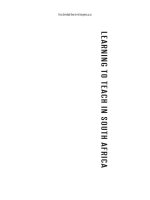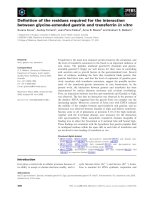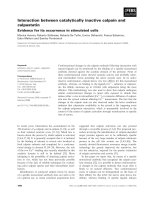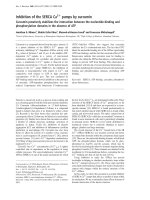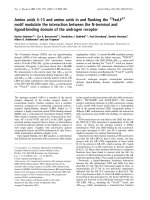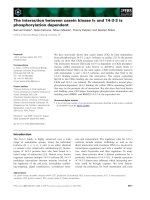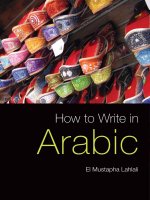INTERACTION BETWEEN LEARNING TO READ AND LEARN TO WRITE IN ELEMENTARY STUDENTS
Bạn đang xem bản rút gọn của tài liệu. Xem và tải ngay bản đầy đủ của tài liệu tại đây (238.46 KB, 10 trang )
<span class="text_page_counter">Trang 1</span><div class="page_container" data-page="1">
<small>Tập 18, Số 11 (2021): 1964-1973Vol. 18, No. 11 (2021): 1964-1973ISSN: </small>
<small>Website: </small>
<b>Research Article<small>*</small></b>
<b>INTERACTION BETWEEN LEARNING TO READ AND LEARN </b>
<b>TO WRITE IN ELEMENTARY STUDENTS </b>
<i><b><small>Huynh Mai Trang </small></b></i>
<i><small>Ho Chi Minh City University of Education, Vietnam </small></i>
<i><small>Corresponding author: Huynh Mai Trang – Email: Received: August 27, 2021; Revised: October 21, 2021; Accepted: November 10, 2021 </small></i>
<b><small>ABSTRACT </small></b>
<i><small>To determine how reading and writing in Vietnamese interact at the primary stage, a longitudinal study of 269 primary students (Grade 2 to 5) was carried out. Collected data include students’ assessment results on oral reading, silent reading, and writing skills in Vietnamese subjects by each school year. The correlation and cross-lagged correlation analysis between these skills confirmed the interaction between reading and writing skills at grade levels. Oral reading skill has positively contributed to writing skill in Grades 2 and 3. Writing skill has positively contributed to silent reading skills in Grade 3 to 5. It can be claimed that at the beginning of literacy acquisition, reading skills (oral reading) have an impact on writing, but when writing skill is mastered, this skill affects reading skills (silent reading). The role of writing in reading is also proposed in the discussion. </small></i>
<i><b><small>Keywords: elementary students; literacy acquisition; learning to read; learning to write </small></b></i>
<b>1. Introduction </b>
Written language is a form of code. Therefore, it can be said that the acquisition of written language is the process of learning to decode them, from characters to sounds (reading) or to encode them, from sounds to characters (writing). Of course, this learning does not happen as naturally as a spoken language but requires systematic instruction in schools.
Reading is not just simply recognizing a word and pronouncing it out loud. The purpose of reading is to understand what is being read. Achieving this goal is a complex process of learning how to read. First, to be able to read, the child needs to know the sounds that correspond to the written words. At the same time, they also need background
<i><b><small>Cite this article as: Huynh Mai Trang (2021). Interaction between learning to read and learn to write in </small></b></i>
</div><span class="text_page_counter">Trang 2</span><div class="page_container" data-page="2">knowledge and a rich vocabulary to understand the words they read. Eventually, a child can automatically recognize most of the words and read them fluently based on grammar, punctuation, and sentence structure.
Thus, reading is the process of recognizing and distinguishing the written words and thereby understanding the meaning of the text. This process does not occur spontaneously but requires specific and systematic guidance. One of the goals of this learning is that readers can automate the word recognition process so that they can focus on understanding sentences and texts. In particular, the decoding or recognition of writing is considered as a prerequisite for understanding the text. Indeed, if reading is easy and effortless in an adept reader, it is because their word recognition occurs almost reflexively (Sprenger-Charolles & Colé, 2003).
Writing is also not simply listening to a sound and translating it into a written word. The goal of writing is to create a text to express your ideas to others. Along with background knowledge and rich vocabulary, there are two groups of skills needed to become a writer: drafting skills (ideas, planning, etc.) and transcribing skills of transcribing into letters (create letters, capitalize, punctuation...). In particular, the skill of transcribing into letters is considered a fundamental and prerequisite factor for writing. According to the research of the authors Content & Zesiger (1999), the method of creating writing is the process of going gradually from mastering the phoneme-grapheme conversion to memorizing written forms. Accordingly, there are two methods of writing: (1) assembling phoneme-grapheme (a word heard is divided into phonemes, these phonemes will be linked to the corresponding graphemes, finally, words will be established by assembling these orthographic segments; (2) retrieve the spelling of a known word, which is stored in memory.
The method of reading and writing differ in at least two ways: in terms of the use of phonemic mediators and the task performed. (1) In the reading mode, it is the conversion from grapheme to phoneme. In writing, it is the reverse transformation, from phoneme to grapheme. (2) For the reading task, to recognize a word, recognizing only part of the written words is almost enough to identify them correctly. However, writing requires precise knowledge of each letter of a word and their order in the word. Thus, one can read a word correctly without necessarily spelling it correctly, but once a word is spelled correctly, it is certain to read it correctly. During formal written language acquisition in schools, learning to read and learn to write takes place in parallel. Because learning to write is more difficult than learning to read, many studies have shown that writing skills are formed later than reading skills (Wimmer & Mayringer, 2002; Landerl & Wimmer, 2008). In addition, there is a certain dissociation between these two skills in children who have difficulty acquiring written language. They can read but cannot write or vice versa. However, this dissociation is uncommon and short-lived.
</div><span class="text_page_counter">Trang 3</span><div class="page_container" data-page="3">Regarding the relationship between these two methods, two basic questions arise: are reading and writing a unified learning process or are they two parallel activities? If there is a relationship between them, what role does each method have to the other? Regarding the first question, there is ample evidence that reading and writing skills are strongly correlated (Content & Zesiger, 1999; Huynh, 2013). Regarding the second question, studies have shown that the relationship between reading and writing is reciprocal (synthesized from Sprenger-Charolles & Serniclaes, 2003). The interaction between reading and writing was also observed with grade development: early elementary school students' writing ability could predict their reading ability, and conversely, the reading ability could also predict their writing ability (Leppanen, Niemi, Aunola & Nurmi, 2006; Cameron, Brock, Murrah, Bell, Worzalla, Grissmer, & Morrison, 2012).
Studies from a neuropsychological perspective also confirm this interrelationship. They particularly emphasize the positive impact of writing on word recognition and reading learning (James & Englehardt, 2012; James & Atwood, 2009).
Thus, it is clear that reading and spelling are not independent skills, however, their influence on each other in different language environments as well as in different learning stages still need to be explored.
The objective of this study was to investigate the link between the reading and writing skills of children learning Vietnamese in primary grades, from the second to fifth grade. The results of this study will contribute to the enhancement of our understanding in the field of written language acquisition at the individual level, in different languages.
<b>2. Method </b>
<i><b>2.1. Sample </b></i>
The research sample includes 296 students, randomly selected from two primary schools in Ho Chi Minh City. The results of these students' Vietnamese tests were compiled from second grade to when they finished fifth grade. In this sample, the number of students who dropped out of school or transferred was excluded to ensure complete and thorough
<i><b>information from second grade to fifth grade of the sample. </b></i>
<i><b>2.2. Data collection </b></i>
Data were collected by reocrding the results of reading and writing Vietnamese of a group of primary school students through the school years, from second to fifth grade, from 2016-2021. These results of the school's year-end examination were assessed by teachers based on the guidance of the Ministry of Education and Training.
The assessment included an oral reading test, a silent reading test, and a writing test. The oral reading test is conducted individually in a listening-speaking format. Students were required to read aloud a passage of text (with a grade-specific volume) and answer questions
</div><span class="text_page_counter">Trang 4</span><div class="page_container" data-page="4">about its content. Students were then assessed on reading accuracy, reading speed, pauses, punctuation, phrases, and answering questions.
The requirements for the silent reading test were that students read a passage of text (with a grade-specific volume) and answered multiple-choice and constructed-response questions (in writing format). Scores were assessed on student paperwork.
The requirements for the writing test were that students tested their spelling skills by a piece of text (with a grade-specific volume) and practice writing. In this test, students were assessed on writing speed, spelling, clarity, cleanliness, correct presentation, and drafting
<i><b>sentences/texts on a topic or a specific requirement. </b></i>
<i><b>2.3. Data analysis </b></i>
To examine the relationship between reading and writing, we used a partial Pearson correlation coefficient between the reading variable and writing variable over time deviation (calculated by school year). For example, the correlation between the second grade's reading result and the third grade's writing performance with the control variable is the second grade's writing performance and vice versa. This method elucidates the causal relationship between variables during development by comparing the magnitude of the partial correlation coefficients (Perfetti et al., 1987, cited by Huynh, 2013). Accordingly, if the correlation coefficient between reading results in second grade and writing results in third grade (control variable is second-grade writing) is higher than the correlation coefficient between second-grade writing and third-grade reading (the control variable is second-grade reading), then it can be inferred that current reading learning predicts subsequent writing outcomes in elementary school students. If the above comparison is opposite, it can be inferred that learning to write now can predict the outcome of learning to read later (Table 1).
<i><b>Table 1. Illustration of cross-lagged correlation analysis </b></i>
<b><small>Variable 1 Variable 2 Control variable Partial correlation </small></b>
<small>If rR-W > rW-R : Reading leads to better writing If rW-R > rR-W: Writing leads to better reading </small>
<b>3. Results and discussion </b>
<i><b>3.1. The correlation between reading and writing in each school year </b></i>
</div><span class="text_page_counter">Trang 5</span><div class="page_container" data-page="5"><i><b>Table 2. Correlation coefficient between results </b></i>
<i>of reading and writing tests in each school year </i>
<i><b>3.2. The interaction between reading and writing through school years </b></i>
<i>3.2.1. The interaction between Silent reading and Writing through school years </i>
<i><b>Table 3. Cross-lagged correlation coefficients between silent reading </b></i>
<i>and writing through school years </i>
<b><small>Correlation coefficients Control variable </small></b>
Table 3 shows that rW-R > rR-V from rade 3 to grade 5. Therefore, it can be said that writing skill achieved at these stages has a constant impact on students’ silent reading skill, while from grade 2 to grade 3, this impact was not observed.
<i>3.2.2. The interaction between Oral Reading and Writing through school years </i>
</div><span class="text_page_counter">Trang 6</span><div class="page_container" data-page="6"><i><b>Table 4. Cross-lagged correlation coefficients between and Writing through school years </b></i>
<b><small>Correlation coefficients Control variable </small></b>
Table 4 shows that the correlation coefficients between oral reading and writing are insignificant in grade 3 and grade 4. However, a comparison of magnitude correlation coefficients in grade 2 and grade 3 (rR-W > rW-R) shows a positive influence of oral reading on students’ writing skills.
Therefore, the cross-lagged correlation coefficients shows the interaction between reading and writing is different depending on the reading test requirements and grade levels. To be more specific, achieving the writing skill first will positively contribute to the current silent reading skill from Grade 3 to Grade 5. Besides, oral reading skills achieved in the previous period will positively contribute to the current writing skill in Grade 2 and Grade 3.
The cross-lagged correlation coefficients of the school year have recognized the interaction between reading and writing skills in different grade levels. However, the direction of this influence varies by grade level andby the specific requirements of reading (silent reading or oral reading). Specifically, in the early years (second to third grade), oral reading positively contributed to writing, and no correlation was observed between silent reading and writing skills. At the end of high school (third to fifth grade), writing skills had a significant impact on silent reading achievement and there was no correlation between reading and writing skills..
The findings of the effect of writing on students' ability to read silently in this study are similar to the findings in research on the effect of handwriting on the functional development of the brain in children. According to James and Engelhardt (2012),
</div><span class="text_page_counter">Trang 7</span><div class="page_container" data-page="7">handwriting is essential for children's brain development and, therefore, can facilitate the ability to learn to read in young children. More specifically, research by Gimenez, Bugescu, Black, Hancock, Pugh, Nagamine, & Hoeft (2014) provided evidence of a link between handwriting quality and functional efficiency of brain regions involved in problem-solving phonemic coding, an important prerequisite for later acquisition of written language.
Other studies have allowed an explanation of the impact of literacy on reading as well as academic performance in general. When copying letters and words, children not only need to control the movements and force of their fingers and hands, but also pay attention to the stimuli involved, keeping their memory active to ensure that all the contents are going to be copied, coordinate hand and eye movements (Maldarelli, Kahrs, Hunt, & Lockman, 2015). Research on fine motor skills development shows a strong link between fine motor skills in general and success in kindergarten. Children with good fine motor skills not only perform better on letter-writing tasks but also in maths in kindergarten (Luo, Jose, Huntsinger, & Pigott, 2007). In addition, these skills are associated with achievement in reading and math by the end of fifth grade (Dinehart & Manfra, 2013). This shows that when children do not have to focus so much on hand and eye movements for writing, they have more energy to process the meaning of numbers and letters, and thus, learning becomes easier.
The discovery of the positive role of literacy in learning to read may force us to revisit the issue of children's writing practice before formal reading. It is clear that directing children to any fine motor practice, non-selective is not the right way to prepare. Children need to practice the fine motor patterns that are directly related to the practice of writing. However, forcing children to write correctly, beautifully, in a straight line is not advisable. At this stage of preparation, children must write freely, without following a pattern and without having to write correctly, since at this stage, children's writing is considered an "invention".
<b>Stimulating creativity in children is what adults need to do. </b>
<b>4. Conclusion </b>
This study has shown a link between reading and writing Vietnamese in primary school students, both at the beginning stage of learning to read and write as well as reaching literacy fluency. The study also explores the direction of influence of these two competencies by analyzing the partial correlation between the competencies over school years. However, the direction of this influence varies by grades and types of reading (silent reading or oral reading). Specifically, writing skills acquired in the previous grade had a significant effect on students' reading achievement in third grade through fifth grade. On the other hand, the results show a positive effect of oral reading on children's writing achievement in the second and third grades. It can be said that when children first learn to read and write, reading skills (oral reading) have an impact on writing, but when they have mastered writing, this skill affects reading skills (reading silently).
</div><span class="text_page_counter">Trang 8</span><div class="page_container" data-page="8">This finding needs to be confirmed by different data sources as well as different data analysis methods so that it can be confirmed that early literacy practice (in a free-form style) is also an important foundation for learning to read in primary school.
<i><b><small> Conflict of Interest: Author have no conflict of interest to declare.</small></b></i>
<i><b><small> Acknowledgments: This study was carried out a 2019 research project, code </small></b></i>
<i><small>CS.2019.19.34, funded by Ho Chi Minh City University of Education. In addition, we were grateful for the data support provided by Truong Dinh Primary School and Thien Ho Duong Primary School in District 10, HCMC</small></i>
<b><small>REFERENCES </small></b>
<small>Cameron, C. E., Brock, L. L., Murrah, W. M., Bell, L. H., Worzalla, S. L., Grissmer, D., & Morrison, F. J. (2012). Fine motor skills and executive function both contribute to kindergarten </small>
<i><small>achievement. Child Development, 83(4), 1229-1244. </small></i>
<i><small>Content, A. & Zesiger, P. (1999). L'acquisition du langage écrit. In Rondal, J. A. & Seron, A. Troubles du langage. Bases théoriques, diagnostic et rééducation. Liège: Mardaga. </small></i>
<i><small>Conrad, N. (2008). From reading to spelling and spelling to reading: Transfer goes both ways. Journal of Educational Psychology, 100, 869-878. </small></i>
<small>Dinehart, L. H. (2015). Handwriting in early childhood education: Current research and future </small>
<i><small>implications. Journal of Early Childhood Literacy, 15(1), 97-118. </small></i>
<small>Dinehart, L. H. B., & Manfra, L. (2013) Association between early fine motor development and later </small>
<i><small>math and reading achievement in early elementary school. Early Education and Development, 24(2), 138-161. </small></i>
<small>Gimenez, P., Bugescu, N., Black, J. M., Hancock, R., Pugh, K., Nagamine, M., Hoeft, F. (2014). </small>
<i><small>Neuroimaging correlates of handwriting quality as children learn to read and write. Frontiers in Human Neuroscience, 8(155). </small></i>
<small>Huynh, M. T. (2013). L'apprentissage de langage écrit et la conscience phonologique en vietnamien. </small>
<i><small>Dans La conscience phonologique des enfants vietnamiens: son développement, ses liens avec la lecture et l’écriture et l’impact d’un entrainement précoce. Saarbrücken: Presses </small></i>
<small>Académiques Francophones. </small>
<small>James, K. H., & Englehardt, L. (2012). The effects of handwriting on functional brain development </small>
<i><small>in pre-literate children. Trends in Neuroscience and Education, 1(1), 32-42. </small></i>
<small>Leppanen, U., Niemi, P., Aunola, K., & Nurmi, J. (2006). Development of reading and spelling </small>
<i><small>Finnish from preschool to grade 1 and grade 2. Scientific Studies of Reading, 3-30. </small></i>
<small>Landerl, K., & Wimmer, H. (2008). Development of word reading fluency and spelling in a </small>
<i><small>consistent orthography: An 8-year follow-up. Journal of Education Psychology, 100, 150-161. </small></i>
</div><span class="text_page_counter">Trang 9</span><div class="page_container" data-page="9"><small>Luo, Z., Jose, P. E., Huntsinger, C. S., & Pigott, T. D. (2007). Fine motor skills and mathematics achievement in East Asian American and European American kindergartners and first graders. </small>
<i><small>British Journal of Developmental Psychology, 25, 595-614. </small></i>
<small>Maldarelli, J. E., Kahrs, B. A., Hunt, S. C., & Lockman, J. J. (2015). Development of early </small>
<i><small>handwriting: Visual-motor control during letter copying. Developmental Psychology, 51(7), </small></i>
<small>879-888. </small>
<i><small>Sprenger-Charolles, L., & Colé, P. (2003). Lecture et dyslexie, approche cognitive. Paris: Dunod. </small></i>
<small>Sprenger-Charolles, L., & Serniclaes W. (2003). Acquisition de la lecture et de l'écriture et dyslyxie: </small>
<i><small>revue de la littộrature. Revue Franỗaise de Linguistique Appliquộe, VIII, 63-90. </small></i>
<small>Wimmer, H., & Mayringer, H. (2002). Dysfluent reading in the absence of spelling difficulties: A </small>
<i><small>specific disability in regular orthographies. Journal of Educational Psychology, 94(2), </small></i>
<small>272-277. doi:10.1037/0022-0663.94.2.272 </small>
</div><span class="text_page_counter">Trang 10</span><div class="page_container" data-page="10"><b><small>SỰ TÁC ĐỘNG QUA LẠI GIỮA VIỆC HỌC ĐỌC VÀ HỌC VIẾT Ở HỌC SINH TIỂU HỌC </small></b>
<i><b><small>Huỳnh Mai Trang </small></b></i>
<i><small>Trường Đại học Sư phạm Thành phố Hồ Chí Minh, Việt Nam Tác giả liên hệ: Huỳnh Mai Trang – Email: </small></i>
<i><small>Ngày nh</small><b><small>ận bài: 27-8-2021; ngày nhận bài sửa: 21-10-2021; ngày duyệt đăng: 10-11-2021 </small></b></i>
<b><small>TÓM TẮT </small></b>
<i><small>Bài viết giới thiệu nghiên cứu về tác động qua lại của việc học đọc và học viết ở giai đoạn tiểu học. Đây là một nghiên cứu bổ dọc trên 269 học sinh tiểu học, từ lớp hai đến lớp năm. Dữ liệu thu thập là kết quả đánh giá kĩ năng đọc thành tiếng, đọc thầm và viết chính tả mơn Tiếng Việt của học sinh theo từng năm học. Phân tích tương quan và tương quan từng phần giữa các kĩ năng theo độ lệch thời gian đã ghi nhận được sự tác động qua lại giữa các kĩ năng đọc và viết ở các khối lớp. Cụ thể là kĩ năng đọc thành tiếng có đóng góp tích cực cho kĩ năng viết ở giai đoạn lớp hai và ba. Cịn kĩ năng viết có đóng góp tích cực cho kĩ năng đọc thầm ở giai đoạn từ lớp ba đến lớp năm. Có thể nói, khi mới học đọc viết thì kĩ năng đọc (thành tiếng) có tác động đến viết, còn đến khi viết đã thành thục thì kĩ năng này đã tác động đến kĩ năng đọc (đọc thầm). Vai trò của việc viết đối với đọc cũng được đề cập trong phần bàn luận. </small></i>
<i><b><small>Từ khóa: học sinh tiểu học; tiếp nhận ngơn ngữ viết; học đọc; học viết </small></b></i>
</div>

